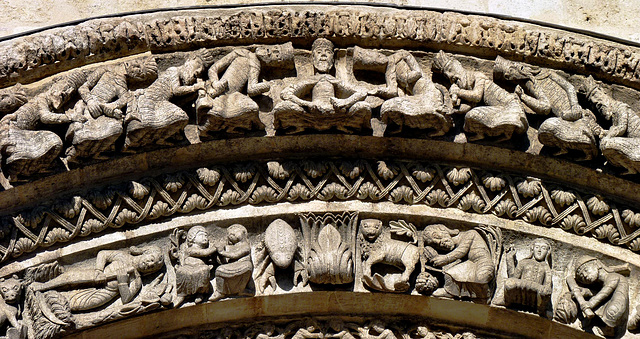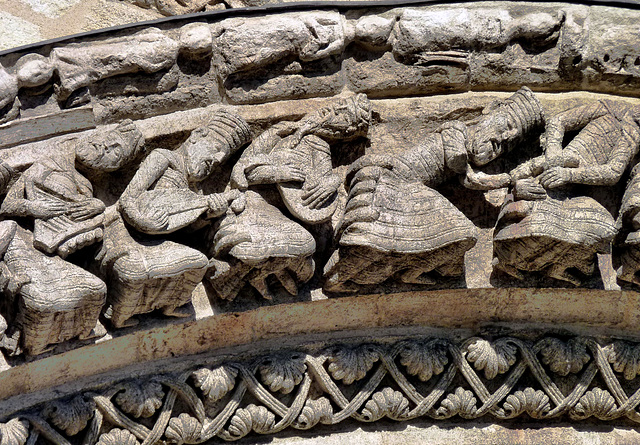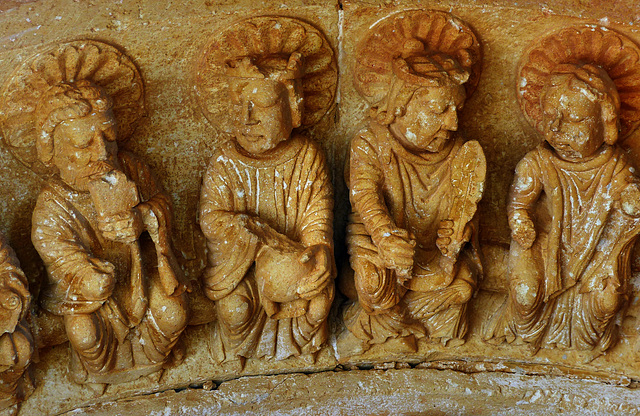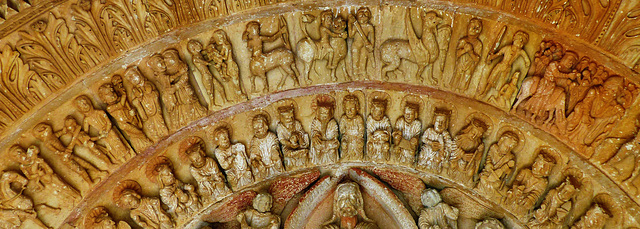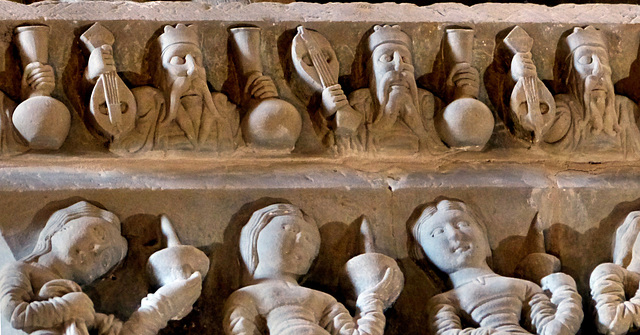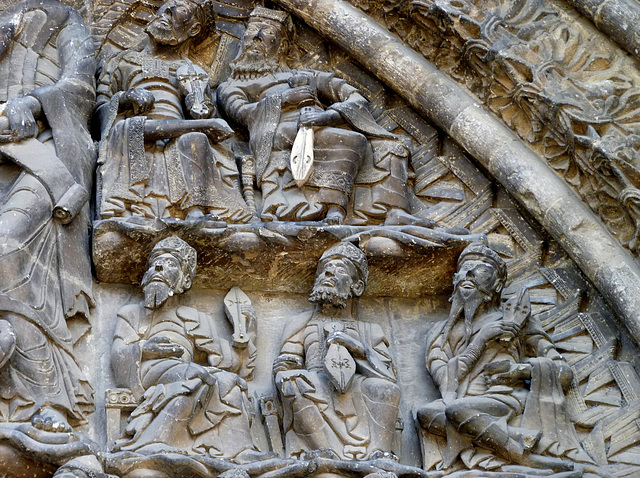
24 Elders
Revelation 4:4
"And round about the throne were four and twenty seats; and upon the seats I saw four and twenty elders sitting, clothed in white raiment, and they had on their heads crowns of gold."
These elders are a common icon found around Europe. They usually hold instruments and sometimes (because of the smell of the rising from the tombs) perfume bottles.
And from time to time the number m… (read more)
"And round about the throne were four and twenty seats; and upon the seats I saw four and twenty elders sitting, clothed in white raiment, and they had on their heads crowns of gold."
These elders are a common icon found around Europe. They usually hold instruments and sometimes (because of the smell of the rising from the tombs) perfume bottles.
And from time to time the number m… (read more)
Bordeaux - Sainte-Croix
The late afternoon sun shines on "Sainte-Croix", the church of the former "Abbatiale Sainte-Croix". The abbey was founded in Merovingian times just south of Bordeaux. The exact year is unknown, but it was mentioned already in 679. The abbey was destroyed by the Saracens around 730 and rebuilt at the end of the century . During the 9th century the Normans raided the area and the abbey got devastated again. Local nobility supported the rebuilding of the abbey by donations and privileges.
The abbey church, built in eleventh/twelfth century, got renovated and rebuilt during the 19th century by Paul Abadie, later known as the architect of "Sacré-Coeur de Montmartre" and strongly influenced by Viollet-le-Duc. His works (eg Saint-Front, Périgueux, St. Pierre, Angoulême) are disputed today, as he "re-created" structures and added details.
The archivolts over the central portal.
The large outer archivolt depicts the "Elders of the Apocalypse", while the large inner archivolt has the signs of the Zodiac and "Monthly Labors". There is the Cancer - and a farmer using a scythe.
Bordeaux - Sainte-Croix
The late afternoon sun shines on "Sainte-Croix", the church of the former "Abbatiale Sainte-Croix". The abbey was founded in Merovingian times just south of Bordeaux. The exact year is unknown, but it was mentioned already in 679. The abbey was destroyed by the Saracens around 730 and rebuilt at the end of the century . During the 9th century the Normans raided the area and the abbey got devastated again. Local nobility supported the rebuilding of the abbey by donations and privileges.
The abbey church, built in eleventh/twelfth century, got renovated and rebuilt during the 19th century by Paul Abadie, later known as the architect of "Sacré-Coeur de Montmartre" and strongly influenced by Viollet-le-Duc. His works (eg Saint-Front, Périgueux, St. Pierre, Angoulême) are disputed today, as he "re-created" structures and added details.
Another close up of the central archivolt. The "Elders of the Apocalypse".
Varaize - Saint-Germain
A priory, dependent from the Abbaye Royale in Saint-Jean-d'Angély, existed here in the 12th century, the church Saint-Germain was erected end of that century. Today it serves the parish - and is in state of urgent repair. The walls of the western facade are cracked and are temporarily stabilized by a construction of wooden beams (previous uploads).
The church is known for the southern portal, a Romanesque masterpiece. Some of the capitals on the sides were "reconstructed" end of the 19th century, but the archivolts are "untouched. Here is a more detailed shot. An Agnus Dei is in the center of the inner archivolt, the Elders of the Apocalypse are seated on an outer archivolt.
Revelation 4:4
"Surrounding the throne were twenty-four other thrones, and seated on them were twenty-four elders. They were dressed in white and had crowns of gold on their heads."
For an unknown reason, within the Poitou, the number of 24 Elders did not seem adequate. In Varaize doomsday needed a little more staff.
Here are 9 (two very weathered) of 37 Elders of the Apocalypse.
Saint Pierre in Aulnay has 31, Notre-Dame in Avy has 36 and the Abbaye aux Dames in Saintes even 54 Elders.
Moradillo de Sedano - San Esteban
Moradillo de Sedano is a small hamlet, about 50kms north of Burgos.
The "Iglesia de San Esteban" was built on a little hill. Following an inscription, the church was completed in 1188. The church has been enlarged during the 14th century, when a Gothic apse was added.
A recently added porch protects the southern portal. Here are the tympanum and the archivolts. Christ (Pantocrator) is seated in the center of an oval mandorla on a sculptured throne (lions). Around him are four angels holding the evangelists´ symbols, flanked by St. Peter and St. Paul. Around the two halfs of the mandorla runs an inscription, that reads "vicit leo de tribu iuda, radix David, alelluia".
There are three archivolts. The outer one has floral patterns, the middle one a mixture of mythical beasts and biblical scenes, while the inner one is populated by the 24 crowned Elders of the Apocalypse. There are twelve on either sides plus one angel in the center.
Here are four of the Elders.
Moradillo de Sedano - San Esteban
Moradillo de Sedano is a small hamlet, about 50kms north of Burgos.
The "Iglesia de San Esteban" was built on a little hill. Following an inscription, the church was completed in 1188. The church has been enlarged during the 14th century, when a Gothic apse was added.
A recently added porch protects the southern portal. Here are the tympanum and the archivolts. Christ (Pantocrator) is seated in the center of an oval mandorla on a sculptured throne (lions). Around him are four angels holding the evangelists´ symbols, flanked by St. Peter and St. Paul. Around the two halfs of the mandorla runs an inscription, that reads "vicit leo de tribu iuda, radix David, alelluia".
There are three archivolts. The outer one has floral patterns, the middle one a mixture of mythical beasts and biblical scenes, while the inner one is populated by the 24 crowned Elders of the Apocalypse. There are twelve on either sides plus one angel in the center.
The center of the middle archivolt depicts from left to right:
Massacre of the Innocents, Annunciation, Visitation, Massacre, Centaur/Sagittarius, Samson, Warrior, Griffin, Massacre, Flight into Egypt
Santo Domingo de la Calzada - Cathedral
The town was founded by the hermit Domingo de la Calzada (aka "Dominic of the Causeway"), who supported the pilgrims on the way to Santiago de Compostela. Domingo not only built a hospital for the pilgrims, but as well a paved causeway and a bridge.
He was such a successful architect, that he is still patron saint of the Spanish civil engineers. The first church, erected by him, got consecrated in 1106. Since 1232 this was the Seat of the Bishops of the Calahorra-La Calzada and Logroño, so the structure got enlarged and modified.
The ambulatory is Romanesque and may (in parts) date back to the first church, built by Santo Domingo. Most of the elaborate carvings may date from the mid/end of the 12th century.
The Elders of the Apocalypse, holding instruments and "golden vials full of odours" (Revelation 5:8), wear impressive beards. The Wise Virgins below look a little sleepy.
Provins - Saint-Ayoul
When in 865 the Normans looted the famous abbey of Saint-Benoît-sur-Loire (= Fleury Abbey), four monks from there saved the relics of Saint-Ayoul, a martyred Bishop of Bourges, by transferring the body secretly to a small chapel in Provins.
In 996 the relics were re-found here, a church was built over the tomb and a priory founded. Provins developed into a place of pilgrimage.
The church burnt down in 1157 and got immediately rebuilt. It got remodeled and enlarged many times until the sixteenth century.
During the French Revolution the church got vandalized, then the priory was sold and the church was used for storage. After it was bought back, the church got restored in the 20th century.
Saint-Ayoul´s portal got severely mutilated by the revolutionary vandals. The Angels, the Saints and the 24 "Elders of the Apocalypse" all lost their heads, But the Elders still hold their instruments and parfum bottles.
Revelation 4:4
"Surrounding the throne were twenty-four other thrones, and seated on them were twenty-four elders. They were dressed in white and had crowns of gold on their heads."
Moissac - Abbaye Saint-Pierre
A legend tells, that the Abbaye Saint-Pierre was founded by Frankish King Clovis in 506, but historians proved that it was indeed founded founded within the 7th century by the Bishop of Cahors.
It was not easy for the convent. It got attacked by moorish troops twice within the 8th century. A hundred years later the Normans rowed up the Garonne and raided the place. After Hungarian troops had looted and destroyed it finally in the 10th century the monastery got rebuilt.
When the pilgrimage to Santiago got popular, the Abbey got affiliated to Cluny and was a major halt on the Via Podensis. This was the golden age for the abbey and the abbots invested in architecture and art. The Romanesque church, consecrated already in 1063, got completely destroyed during the Albigensian Crusade.
The portal, created 1110/1130, survived the times. It is a great piece of Romanesque art.
This is a small detail of the tympanum, that refers to the Book of Revelation. The apocalypse is a common theme on tympana along the pilgrim-routes during the 12th century (eg. Morlaas, Conques, Aulnay, Saintes...).
The Elders of the Apocalypse, holding their vielles, are masterly carved and very rich in details. They are all focussed on Christ in the center - and sit very relaxed.
Revelation 4:4
"Surrounding the throne were twenty-four other thrones, and seated on them were twenty-four elders. They were dressed in white and had crowns of gold on their heads."
Moissac - Abbaye Saint-Pierre
A legend tells, that the Abbaye Saint-Pierre was founded by Frankish King Clovis in 506, but historians proved that it was indeed founded founded within the 7th century by the Bishop of Cahors.
It was not easy for the convent. It got attacked by moorish troops twice within the 8th century. A hundred years later the Normans rowed up the Garonne and raided the place. After Hungarian troops had looted and destroyed it finally in the 10th century the monastery got rebuilt.
When the pilgrimage to Santiago got popular, the Abbey got affiliated to Cluny and was a major halt on the Via Podensis. This was the golden age for the abbey and the abbots invested in architecture and art. The Romanesque church, consecrated already in 1063, got completely destroyed during the Albigensian Crusade.
The portal, created 1110/1130, survived the times. It is a great piece of Romanesque art.
This is a small detail of the tympanum, that refers to the Book of Revelation. The apocalypse is a common theme on tympana along the pilgrim-routes during the 12th century (eg. Morlaas, Conques, Aulnay, Saintes...).
The Elders of the Apocalypse, holding their vielles, are masterly carved and very rich in details. They are all focussed on Christ in the center - and sit very relaxed.
Revelation 4:4
"Surrounding the throne were twenty-four other thrones, and seated on them were twenty-four elders. They were dressed in white and had crowns of gold on their heads."
Jump to top
RSS feed- Latest items - Subscribe to the latest items added to this album
- ipernity © 2007-2024
- Help & Contact
|
Club news
|
About ipernity
|
History |
ipernity Club & Prices |
Guide of good conduct
Donate | Group guidelines | Privacy policy | Terms of use | Statutes | In memoria -
Facebook
Twitter

